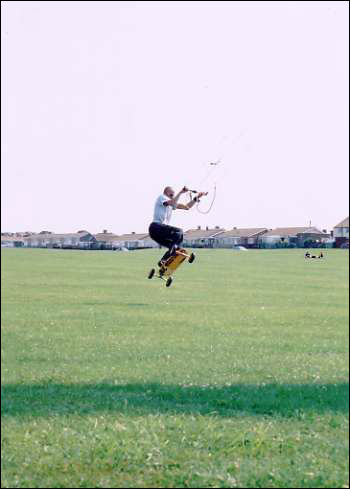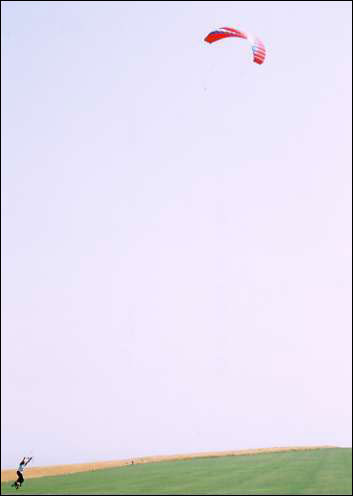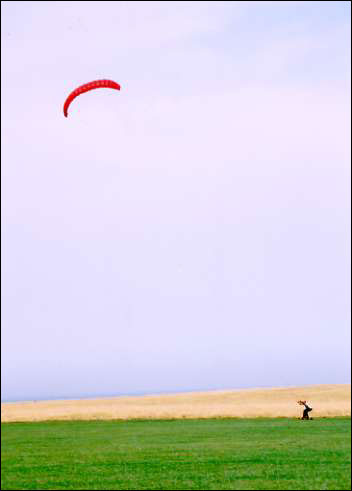One of the hardest mysteries to unravel in kiteboarding is the art of jumping. Difficult to translate in pure words, ive compiled the following pictures and advice built up over the last year. My thanks go to all those who've helped, in particular my good friend Mr. Brendan Gill.
山地滑板跳跃--- Bushflyer文
在风筝滑板技巧里最复杂最神秘的就算是跳跃技巧了。单纯用语言很难讲的明白,下面通过附带的图片对跳跃技巧进行解释,这里特别感谢帮助过我的朋友们,尤其是我的好朋友Brendan Gill
The first steps - Preparation
Firstly, i need to stress how important it is to have your kiteskills up to a good level before attempting air. You should be able to ride both heelside and toeside in both directions on your board. If you're not familiar with these attitudes when attempting air for the first time you're asking for trouble. trust me, the first few times you'll be concentrating on so many things you need to know your kite's position and attitude in relation to the wind instinctively. A powering up moment with the kite in the wrong position can be very bad indeed.
第一步 准备阶段
首先,我需要强调一下,对自己控制风筝的技巧的熟练度的了解是非常重要的。你必须能熟练的能正向和反向的滑水。如果你还没有做好这些准备,我相信一开始一定会遇到麻烦,你必须同时集中精力关注你的风筝的位置,以及本能的关注风向变化等等。如果不能准确的估计风向,那已经会很糟!!
Another important aspect so often overlooked, and the most simple is jumping without the kite on the board. Best practised on longish grass or soft sand at first to prevent the board from rolling from under your feet. Lower your centre (hips) and spring up, raising both knees simultaneously. Semi-straighten your legs and absorb the landing while using your hands to maintain balance. Practice this until you can land comfortably keeping the weight in the centre of the board, not overly leaning either heel or toeside. Doing this at speed can lead to some spectacular faceplants! The key is to remain calm, relaxed and confident. breaking down the moves, developing solutions and analysing your mistakes from this early stage gaurantees success.
另一个非常重要的因素常常被忽律,那就是如何在无风筝牵引下如何在板上跳跃,最好是选择在柔软的草地火车沙地上进行跳跃训练。基本步骤是先压低身体重心,然后双膝同时向上拔,落地时双膝微屈减震以维持平衡。反复练习直到能熟练的掌握落地时的平衡--重心保持在两腿中心,即不要前倾也不要后压。这个练习的重点还是有保持冷静,放松,在每次练习中体会动作要领
Step two - The first jumps; fast and low
第二步 第一次跳跃;快 低
Okay, firstly find yourself a large area with a clean wind. This is important becuase firstly you dont want to rush into your first airs; give yourself a good run up to get your position on the board sorted and load up the kite. Also, having a run-off area is vital as mistakes will happen (i still fall off, you cant forsee everything ;D ). Though the pro's can use gusty winds to their advantage, going out for your first jumps in such conditions is not advisable. The power levels can change in an instant, often in mid air.
首先要有稳定的海风,这对初学者是十分重要的,然后调整自己在板上的合适的位置并拉起风筝。不过选择缓冲地带也很重要(就连我自己也有时会失手,情况总是多变的:))在第一次试跳时选择强劲的大风天气是不合适的,因为风力在中空位置可能会有变化而变的很难控制
So, with the wind somewhere between 10 and 15 mph (dependent on your weight and kite size, please use discretion) get on the board and power off toward your takeoff point.

所以选择10—15米/秒的风速较为合适(当然这样根据自己的体重和风筝的大小)
Start loading the kite up once you're at a comfortable speed by steering slightly upwind to build tension on the lines. Also put your centre over the heelside edge of the board. Remember, a mountianboard cannot hold as much power as a twin tip so dont overdo it. When you're ready send the kite back to around 11-11:30 in the window and steer slightly upwind and jump as mentioned previously.
起步在合适的速度下慢慢拉高风筝,牵引线要吃上劲!主要这时要不重心放在滑板的外沿。山地滑板不能承受太大的力量,所以注意适当发力,当风筝在大概头顶11点钟方向时,开始按之前的步骤尝试跳跃


As soon as you take off REDIRECT THE KITE IN THE PREVIOUS DIRECTION. This maintains the direction of travel and stops the kite luffing. Sound complicated? Try breaking it down into these parts:
落地后,风筝恢复之前的位置。保持前进方向并不要让风筝改变方向。以下是分解步骤
STAGE 1
Send the kite back and jump and redirect the kite (note bar position)
第一步
用力往回拉风筝,并重新调整风筝位置(注意把手位置)

STAGE 2
Once stage one comes naturally to you, now try edging the board harder just before takeoff and bring up your knees. This should make you go higher.
第二步
第一步准备结束后,在起跳前开始屈膝压刃,这样可以跳跃的更高
Troubleshooting
Having trouble boosting ?
Alter your timing - wait until the kite starts to physically lift you into the air.
常见问题
升空问题
调整节奏,感到风筝开始往上提升时再发力跳跃
Landing hard ?
Redirect the kite more and/or keep it higher in the window. Uplift, not lateral pull is the name of the game here.
着落问题
调整风筝位置或者继续保持风筝的高角度位置


Going bigger
1. Lower your centre more and spring up on takeoff. this retains more energy in the kite allowing higher boosting.
2. Perfect your timing. timing is everything!
3. Send the kite back further in the window. this gives even more energy to the kite. Be careful!
4. Hook in and/or use depower (if available)
1 进一步压低重心以为跳跃提供更强的弹跳力
2 控制好节奏,这是最重要的环节
3 试风筝返回到窗户位置,这样可能会让风筝有更强的提升力
4 收拢或想办法卸力
Remember, know your own limits and fly responsibly, dont showboat close to others (especially if they're directly downwind) and take your time. small steps lead to great things.
记住一定要量力而行,学会控制节奏,一步一步的进行升级,切勿操之过急
Get trying!
